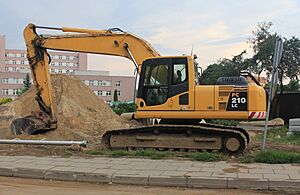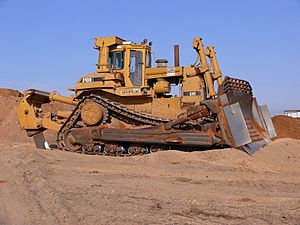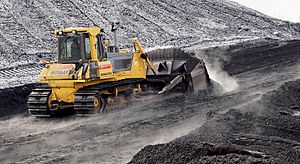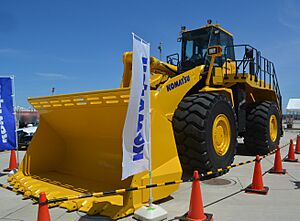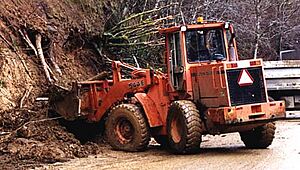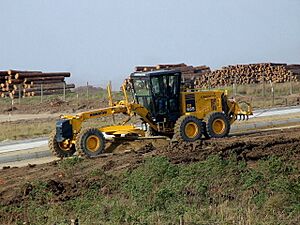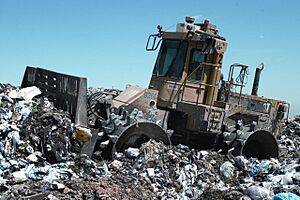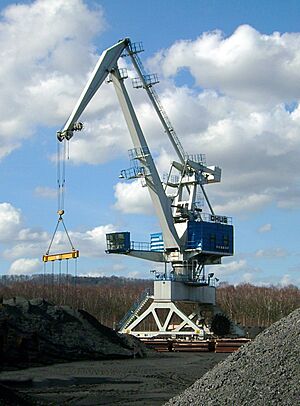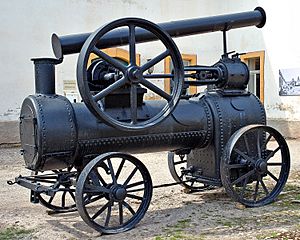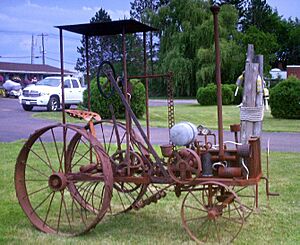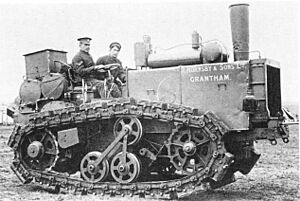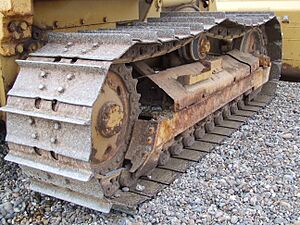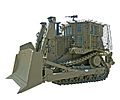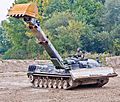Heavy equipment facts for kids
Heavy equipment are super strong machines used for big jobs like building roads, bridges, or digging huge holes. You might also hear them called heavy machines, construction equipment, or heavy vehicles. These powerful machines are usually driven by skilled workers who have special training.
Many of these machines use special tracks (like a tank) to move over rough ground, while others use big tires for faster movement on smoother surfaces. The type of tires or tracks chosen helps the machine work best for its specific job.
Heavy equipment works by using a simple idea called leverage. This is like using a long stick to lift something heavy – it makes the work much easier. Most of these machines get their power from diesel fuel, which is a type of fuel that helps them do really tough tasks.
Contents
What Heavy Equipment Does
Heavy equipment is designed to do many different kinds of tough jobs that people can't do alone. These machines help us build the world around us!
- Moving Earth: They can dig up huge amounts of dirt, sand, or rocks and move them from one place to another. This is called "earthmoving."
- Lifting Heavy Things: Some machines are built to lift incredibly heavy objects, like steel beams for buildings or large concrete blocks.
- Breaking Things Down: They can also break apart old buildings, roads, or rocks to clear the way for new construction.
- Preparing Ground: Before building, the ground often needs to be leveled or packed down. Heavy equipment does this quickly and efficiently.
Types of Heavy Equipment
There are many different kinds of heavy equipment, each designed for a special purpose. Here are some common types:
Excavators
An excavator is a machine with a long arm and a bucket at the end. It's like a giant mechanical arm that can dig deep holes, scoop up dirt, and load it onto trucks. They can also be used to break concrete or cut down trees with different attachments.
Bulldozers
A bulldozer is a powerful machine with a large metal blade at the front. This blade is used to push huge amounts of earth, sand, rubble, or other materials. Bulldozers are great for clearing land, leveling ground, and helping to build roads.
Loaders
Loaders have a large bucket at the front that can scoop up materials like dirt, gravel, or sand. They then lift the bucket to load these materials into dump trucks or move them around a construction site. There are both wheel loaders (which have tires) and track loaders (which have tracks).
Graders
A grader is a machine with a long blade in the middle, between its front and rear wheels. This blade is used to create a flat surface, like when building roads or leveling ground for construction. They are very precise and help make sure surfaces are perfectly smooth.
Compactors
Compactors are machines that have heavy rollers or vibrating plates. They are used to press down and flatten soil, gravel, or asphalt. This makes the ground or road surface strong and stable, preventing it from sinking or cracking later.
Cranes
Cranes are tall machines used to lift and move very heavy objects, often to great heights. They are essential for building tall buildings, bridges, and other large structures. Some cranes are fixed in one place, while others can move around on wheels or tracks.
How They Work
Most heavy equipment uses a system called hydraulics. This means they use pressurized liquid (usually oil) to create a lot of force. When the operator pushes a lever, it sends oil through hoses to cylinders, which then push or pull parts of the machine, like the arm of an excavator or the blade of a bulldozer. This hydraulic power is what makes these machines so incredibly strong.
The engines in these machines are usually very large and powerful, often running on diesel fuel. This fuel provides the energy needed to power the hydraulics and move the heavy parts of the machine.
History of Heavy Equipment
For a long time, people used animals like horses or oxen, along with simple tools, to do heavy work.
- Early Days: Simple machines like the Fresno scraper, pulled by horses, were used to move earth for canals and roads.
- Steam Power: In the 1800s, steam engines started to be used to power early versions of tractors and other machines. These were big and noisy but much more powerful than animals.
- Gasoline and Diesel: In the early 1900s, gasoline and then diesel engines became common. These engines were smaller, more efficient, and more powerful, leading to the development of the modern heavy equipment we see today.
- Tracks and Tires: The invention of continuous tracks (like those on a tank) allowed machines to move over very rough or soft ground. Later, specialized tires were developed for different types of terrain and jobs.
Today, heavy equipment is vital for almost all large construction projects, helping us build cities, roads, and infrastructure all over the world.
Images for kids
-
Caterpillar D9L bulldozer, excavators and other heavy equipment vehicles parked near a quarry in Israel
-
Bucket-wheel excavators in Garzweiler surface mine, Germany
-
Iron bar reinforced foundation piles are driven with a drilling machine, concrete pump, mixer-truck, and a specialized auger that allows pumping concrete through its axis while withdrawn.
-
PiPz Dachs armoured engineering vehicle of the German Army (2008)
See also
 In Spanish: Maquinaria de construcción para niños
In Spanish: Maquinaria de construcción para niños


